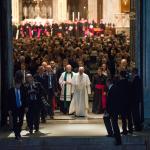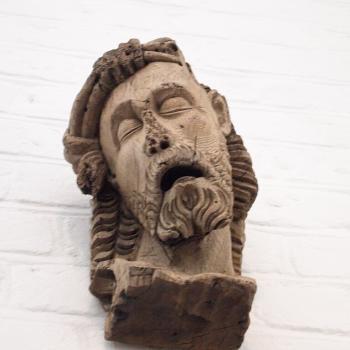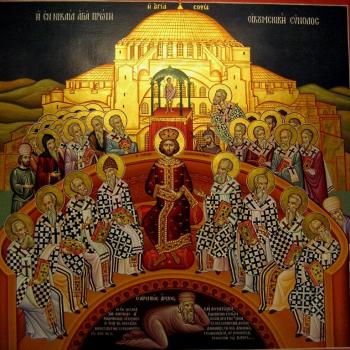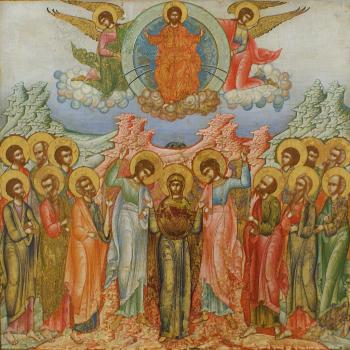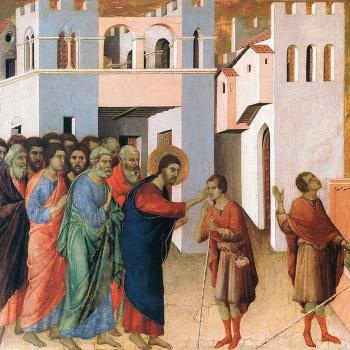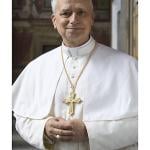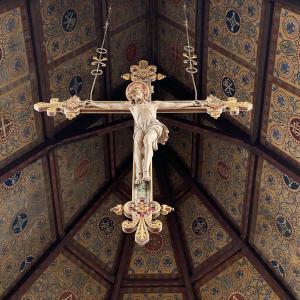
The Son of God assumed human nature to become the Son of Man. Paul tells us this was done through kenosis, that is, self-emptying, so that Jesus, being the form (or nature) of God, emptied himself of all that glory to become one of us: “Have this mind among yourselves, which was in Christ Jesus, who, though he was in the form of God, did not count equality with God a thing to be grasped, but emptied himself, taking the form of a servant, being born in the likeness of men” (Philip. 2:5-7 RSV). Jesus, rich in divinity, took on our poverty so that we could be enriched by the glory of his divinity:
And did He not for our sake, though rich and invested with power over everything, take on our poverty along with the kingship itself, in order that we, who are so very poor, might become rich in his imperishable riches and rule with his sovereignty? And did He not, though being uncreated and, what is more, being Maker and Creator of all creation, accept to be counted among creatures, in order to share with us his uncreated nature? [1]
In the incarnation, Jesus did not just take on human nature, and by that alone, be said to have become empty of the divine glory. He emptied himself further, taking on human poverty, joining himself in solidarity with the poor, becoming one of them. “God is swaddled in humble rags, so who will become rich in the divinity of God by embracing whatever is lowly? For it was with this in mind that He put on the poverty of human beings, namely, to make us gods by grace.” [2] The preferential option for the poor is demonstrated in the incarnation, for it is among the poor that God is to be found; even if Jesus’ family was not among the poorest of the poor, he willingly went beyond his humble birth, to become a wandering holy teacher with no place to call his own, no place of his own to rest his head (cf. Lk. 9:58). Thus, in his humanity, he continued the work of the incarnation, continued his kenosis, divesting himself of all things, so that we can see that his poverty was voluntary and done out of love. He pointed to the poor, to those in need, and said he is to be found in and with them, so whatever is done to or for them, is done to or for him (cf. Matt. 25:31-46).
If we want Jesus, if we want to follow after him, we need to discern where we can find him: it is in and with the poor. It is also in and with the poor, as one of the poor, as one of the downtrodden of society, he was executed; he was one of the many poor victims of society, one of those whom society casts aside and kills once they say or do something which disturbs it. He allowed himself to become the sacrificial victim, to become the poorest of the poor, to put aside all earthly things, even his life, in order to show the extent of his love. In his resurrection, he has become the vindication of the poor and downtrodden; he took all those who were lowly and oppressed and made them his own. This is why when we look to him on the cross we should see who he truly is, the poor victim, the one who has emptied himself of all things so that he could stand in solidarity with the poor and embrace them. But he did more than that; he went beyond mere solidity with the poor, for he became one of them, uniting himself with them just as he united himself with the whole of humanity in the incarnation.
Certainly, when talking about poverty, we can point out there is both a material and a spiritual form of it. We are all spiritually impoverished due to sin; if we do not embrace that, if we do not realize how impoverished we are, if we do not accept that we are in need of the spiritual graces of Christ, we will not be able to united with him and share in the glory of the resurrection. However, if we embrace our spiritual poverty, if we realize our sin and the affects that our sin has had on the world, we will also be able to see how all sin has harmed the world. We will be able to see how sin has created the underclass, those who are materially impoverished and unjustly suffering at the hands of others (such as is found in systems engaging racism or misogyny). With this realization, we must promote the reversal of sin and all the harm that it has done, which means, we will promote the cause of those sin has harmed. We will indeed see that, due to the incarnation, and the kenosis of the Son, the Son will be found among the poor, among the downtrodden and the abused. Then, if we want the Son, we will not look for him amongst the rich and greedy, among those who pursue their own glory at the expense of others, but among those whom the powers that be have hurt. We will find Jesus in and with the poor, the needy, the oppressed.
If we truly decide to follow Jesus, we will accept him where he is at, among the poor, and in our embrace of him we will embrace all those whom Jesus embraced, lifting them up even as Jesus lifted up, knowing that in doing so, what we do for them we do for Jesus. If we truly want to glorify the poor victim on the cross, we must recognize and love the poor in Jesus. Indeed, when we embrace Jesus, when receive Jesus in communion, we receive the one who became one of the poor to embrace them and lift them up. If we receive him, we are to say yes to him, yes to what he did, yes to his teaching, and so we are to say yes to the poor and needy, yes to the abused and oppressed wherever they are found, and promote them and their cause, for that is the cause of Jesus. If we want to have any “eucharistic coherence” we must embrace Jesus and his solidarity and unity with the outcasts of society. For, as the eucharist is Jesus, all those embraced and promoted by Jesus is to be embraced and promoted in our reception of the eucharist. Indeed, we must remember, one of the points of the eucharist, indeed, one of the points of any of the sacraments, is that it is meant to bring us together as one. “All the sacraments have for their object the developing of unity, likeness and simplicity among men.” [3] Any eucharistic coherence, any sacramental coherence, must stand with Christ in his embrace of all, lifting up those who have been pushed down and harmed the most by society; if we try to teach the eucharist without teaching who Jesus is and how he came to be among the poor and promoted the poor in his very being, we will not be able to have any true eucharistic coherence.
[1] St Sophronios of Jerusalem, “Homily 2: Homily on the Divine Birthday oof the Savior Falling on a Holy Sunday and on the Disorder and Destructive Insurrection of the Saracens” in Homilies. Trans. John M. Duffy (Cambridge: Harvard University Press, 2020), 37.
[2] St Sophronios of Jerusalem, “Homily 2,” 25.
[3] John Colet, “Celestial Hierarchy” in Two Treatises on the Hierarchies of Dionysius. Trans. Joseph Hirst Lupton (London: Chiswick Press, 1869), 77.
Stay in touch! Like A Little Bit of Nothing on Facebook.
If you liked what you read, please consider sharing it with your friends and family!



